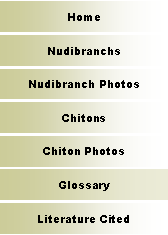
|
glossary |
|
Aposematic Coloration: Bright or gaudy coloration patterns that indicate to predators that an animal is distasteful or poisonous to eat. Classic examples include Poison Dart Frogs. Bilateral symmetry: When a body type can be divided down a mid-line creating two equal halves. Carnivorous: Flesh eating or engaging in predatory behavior by eating other animals. A carnivore. Ceras (pl. cerata): Multifunctional dorsal and lateral outgrowths of a nudibranch’s body. In species with transparent or translucent cerata skin, much of the cerata coloration is dependent upon the color of the nudibranch’s food choice as it passes through the digestive tract. The cerata functions include: 1. Digestion gland. In many species the digestive gland found in the cerata are a duct lined with digestive gland cells. 2. Respiration. In nudibranch species with cerata, the thin walled cerata function as gills facilitate gas exchanges for the circulatory system. 3. Defense. At the tip of most aeolid cerata, there is a cnidosac that stores stinging nematocysts. Chiton: Phylum Mollusca, class Polyplacophora. Characterized by eight dorsal plates or valves held together by an outer girdle. Cnidosac: A sac found at the tip of some aeolid cerata. Stores stinging nematocysts which are used as a defensive measure. Cnidaria: Phyla containing jellyfishes, hydroids, sea anemones, sea pens, corals and related organisms. Commensal: Relationship between two species with where one member of the association benefits but the second member is neither harmed nor benefited. Cryptic Coloration: Camouflaging. Coloration that allows an animal to blend with their surroundings. Dorsal: Anatomical reference to the back or upper surface of a body. Foot: In phyla Mollusca, the foot is the organ used for crawling or locomotion. Herbivorous: A plant eating animal. A herbivore. Intraspecific Coloration: Color variances found within a species. Lateral: Anatomical reference to the sides of a body. Mantle: In phyla Mollusca, the outer sheet of tissue. Functions can include secreting the plates (shells) in addition to enclosing the body cavities Nematocysts: A cnidarians stinging defensive capsule. When a nudibranch ingests a cnidarian, the nudibranch can absorb the nematocysts, store them in the cnidosac cerata structures, and then discharge the nematocysts in the nudibranch’s own defense. Papilla: Finger-like extensions found on the dorsal surface of some nudibranchs. Not involved in digestion or defense. Plates: The shell pieces or valves of a chiton. Radula: File like extensible feeding structure made up of numerous chitinous teeth. Various molluscs use a radula to scrape algae, diatoms or hydroids off substrate. Rhinosphores: Paired sensory apparatus found on nudibranch head – not tentacles. Rosette: Gill structure found on some nudibranchs. Flower shaped circlet or structure usually found on the posterior dorsal surface. Ventral: Anatomical reference to the underside of a body. (Behrens 1991, Kozloff 1993, Kozloff 1996, Levinton 2001, Sept 1999) |

